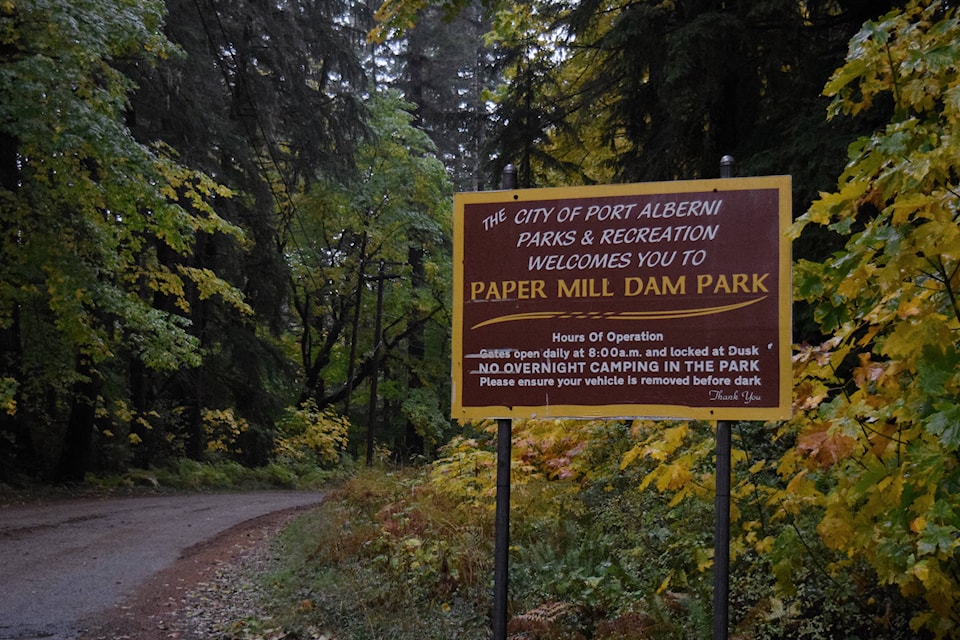The Alberni Valley has its fair share of haunted history. The area drew attention in 2009 when the B.C. Cryptozoology Club speculated about the presence of a sea serpent-like “creature” living in Cameron Lake.
The Rollin Art Centre on 8th Avenue was a house built by Fred and Ellen Rollin around 1914, and the Community Arts Council took possession in 1977. According to former administrator Meg Scoffield, Fred Rollin had regaled children from the next-door Eighth Avenue School with tales of a ghost in the attic—although Scoffield never saw the ghost herself.
There is also the unsolved Sproat Lake mystery. Jan Peterson in Twin Cities: Alberni—Port Alberni recounts how a farm house belonging to Nils Hilmar Weiner exploded one night in 1944, leading to a devastating fire. Neither Weiner nor his remains were ever found.
But according to researcher and writer Shanon Sinn, the most unique haunting in the Valley’s history is an apparition of a woman seen on or nearby the Somass River at the Paper Mill Dam Park.
Sinn runs the blog “Living Library,” where he researches folklore, mythology and hauntings from a journalistic perspective. His book, The Haunting of Vancouver Island: Supernatural Encounters with the Other Side, available through Touchwood Publications, was released on Oct. 10, and features various stories from across Vancouver Island—including “The Lady Who Walks On Water” from Port Alberni.
Sinn describes multiple stories posted to his website, “Living Library,” of a woman who is seen walking on the water of the Somass River in the middle of the night. The apparition glides along the surface of the water and asks, “Have you seen my baby?”
In 1892, British Columbia’s first paper mill was built on the Paper Mill Dam site, according to Peterson in her book, The Albernis: 1860-1922. The historic millstones that now sit at Millstone Park are from this very paper mill. Paper was produced during 1894 and 1895, but due to heavy expenses and poor material, the mill was not able to keep up production and closed. In 1915, the dam itself was destroyed on instructions from the Dominion Fisheries to allow schools of salmon to migrate further up the Somass River to their natural spawning grounds.
“Port Alberni residents claim that the haunting is old,” Sinn writes in The Haunting of Vancouver Island. “One commenter on my blog said that her grandmother—82 years old in 2014—remembers hearing about the ghost when she was ‘a little girl.’ If true, this would make the tale as old as the late 1930s or early ‘40s at the very least.”
According to Sinn, the image of a female spirit searching for her child is a fairly common motif. He specifically describes La Llorona, or “weeping woman,” a well-known tale in Mexico and the United States. Supposedly, La Llorona was a beautiful woman whose husband left her for a younger, wealthier woman. The legend says that she drowned her children in a fit of rage, and her body was discovered on the riverbank. She still haunts the river to this day.
Sinn suggests that because of the similarities, the detail about the spirit asking for her child could be a modern addition to the story.
But, he says, the Paper Mill Dam story has “unevolved edges” that lead him to suspect the tale is more than just an urban legend.
Another visitor to Sinn’s blog also comments that the park has “sightings of weird-coloured light orbs and shadow figures.” Stamp Falls—a tributary of the Somass River—also has reports of “hovering ghost-light orbs.”
When asked, volunteers at the Alberni District Historical Society and Community Archives relayed stories about swimmers who disappeared into a “tunnel” beneath the water near the former Paper Mill Dam site. But, they said, these stories are all hearsay and speculation.
However, this “tunnel” could also be explained away by whirlpools or “holes” in the river.
So is the river really haunted after all? Sinn suggests that the interpretation of a ghost story is complicated:
“…the oral telling of a story becomes somewhat like the broken telephone game, in which details gets altered even if it was never a teller’s intention. Because ghost stories are somewhat like fisherman’s stories, they become exaggerated and distorted intentionally as people try to one-up each other.
“In the case of hauntings, making the tales as frightening as possible is often seen as a good thing. By the time the experience has been recorded, it has usually been altered to some degree.”
Perhaps something did occur at the Paper Mill Dam site to start speculation of hauntings. But in the end, the ghost story comes down to whether you believe it or not.
